7.1 Flat roofs and balconies
SITEWORK STANDARDS
(a) meet the Technical Requirements
(b) take account of the design
(c) follow established good practice and workmanship
Construction that complies with the design and the guidance below will be acceptable for flat roofs and balconies.
IN-SITU REINFORCED CONCRETE
Items to be taken into account include:
(a) accuracy of formwork
The formwork should be constructed accurately.
Items to take into consideration are:
- accurate location of holes
- adequate support
- proper allowance for placing of steelwork
- cast-in features, such as drips and weatherchecks
- surface finishes.
(b) concrete grade
Reference should be made to Chapter 2.1 'Concrete and its reinforcement' for guidance on concreting. The design should have specified a concrete mix with low shrinkage characteristics.
PRECAST CONCRETE
The supporting structure should:
- be even and true
- have a minimum 90mm bearing for the pre-cast units unless the design shows a lesser dimension.
Precast units should be:
- installed to provide an even surface
- grouted, where required by the design.
TIMBER
Items to be taken into account include:
(a) grades and sizes of joists
Materials delivered to site should be checked for conformity with the design and specification.
(b) the spacing and bearing required to achieve reasonably level support for firrings and decking
Timber joists should be:
- level - where necessary, hard packing should be used, eg tiles or slates bedded in mortar. Loose or soft packing, including timber, should not be used
- spaced at the centres specified on the drawing (not more than 600mm centres).
The use of regularised timber joists will help to achieve a level ceiling.
(c) strutting
Strutting should be one of the following:
- herringbone type (timber 38mm x 38mm)
- solid blocking (38mm thick timber x ¾ depth of joist)
- proprietary steel strutting.
Strutting should be located as follows:
| Joint span [m] | Rows of strutting |
| Up to 2.5 | none needed |
| 2.5 to 4.5 | 1 (at centre of span) |
| Over 4.5 | maximum 2.5m centres, spaced equally along the span |
In cold deck roofs, the strutting should not prevent free cross ventilation.
(d) holding down metal strapping
If the design specifies holding down straps to prevent the roof being lifted off the supporting structure, they should be at a maximum of 2.0m centres.
Where straps are fixed to masonry, hardened nails 4mm in diameter x 75mm long or No 12 wood screws into plugs x 50mm long should be used.
The number of fixings should be in accordance with design requirements and the lowest fixing should be within 150mm of the bottom of the vertical strap.
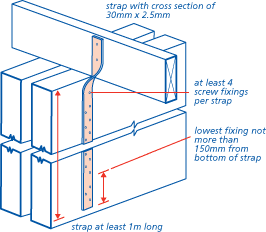
(e) timber quality
Timber should be rejected if it:
- is excessively bowed, twisted or cambered
- is excessively wet
- has large edge knots or shakes
- has a waney edge more than half the thickness
- has fissures
- has any sign of rot.
Where treated timber has been cut on site, re-treat cut edges with a coloured preservative.
JOIST HANGERS
The joist hanger should be the correct size for the timber joist or trimmer and nailed in accordance with the design.
The masonry course to carry the joist hangers should be level and at the correct height. Do not cut into the walling.
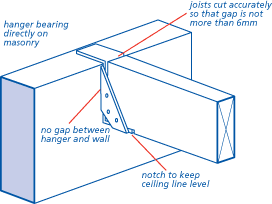
FALLS
Falls and gutters should be constructed in accordance with the design. Falls to flat roofs and balconies should have finished falls of not less than 1:80. Twice this figure (1:40) should be used for installation purposes.
Items to be taken into account include:
(a) falls on concrete roofs
CEMENT/SAND SCREEDS
Cement sand screeds should be 1 : 4, cement : sand. Minimum screed thicknesses should be as follows:
| Location of screed | Minimum thickness [mm] |
| Bonded monolithically to in-situ concrete | 25 |
| Laid on in-situ concrete | 40 |
| Laid on precast concrete | 50 |
| Laid on woodwool | 13 (sealing screed) |
Reference should be made to Chapter 8.3 'Floor finishes' for further guidance on laying screeds.
LIGHTWEIGHT SCREEDS
Lightweight screeds should be laid only by specialist contractors. Lightweight concrete screeds should have a topping of 1 : 6, cement : sand, 13mm thick.
SCREED FINISH
Screeds should be free from ridges and indentations. They should be finished with a wooden float to provide a smooth, even surface for the vapour control layer and waterproof finish.
PROTECTION AGAINST TRAPPED MOISTURE
When laying wet screeds, allowance should be made for draining away excess moisture.
(b) falls on timber roofs
Firring pieces should be used to form falls, unless the design shows sloping joists and ceiling. Where laid across the joists, firrings should be not less than the following sizes:
| Joist centres [mm] | Minimum firring dimensions [mm] | |
| width | depth | |
| 400 or 450 | 38 | 38 |
| 600 | 38 | 50 |
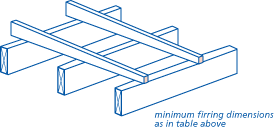
DECKING
Items to be taken into account include:
(a) fixing of softwood boarding
Softwood tongued and grooved boarding should be closely clamped together. Each board should be nailed with two ring shank nails to each joist or firring. Nail heads should be punched below the timber surface.
End joints should be staggered. Boards should be no greater than 100mm wide.
(b) fixing of plywood, chipboard and oriented strand board
Tongued and grooved boards laid either with the long edge at right angles to the joists or parallel to the joists should have the short edge supported on a joist or nogging.
Oriented strand board should be laid over supports in the direction indicated on the boards. The stronger axis should be laid at right angles to the supporting joists.
With any profile board, perimeter edges which do not coincide with joists should be supported on noggings.
In accordance with manufacturers' recommendations, gaps should be left around boards for movement.
The table below shows recommended fixing centres and allowances for movement between boards:
| Chipboard and oriented strand board [mm] | Plywood [mm] | |
| Fixing centres: In external conditions - at board perimeters | 200 to 300 | 150 |
| - elsewhere | 400 to 500 | 300 |
| Movement gaps: - between square edge boards | 3 | 2 |
| - at abutments with rigid upstands | 10 | 5 |
Designs may require fixing centres closer than those shown above, particularly in areas where high wind speeds are experienced. Where this occurs, the design centre dimensions should be used.
Chipboard and oriented strand board should be fixed with flat headed ring shank nails, 3mm in diameter at least 2½ x board thickness long and not less than 9mm from the edge of the board.
Plywood should be fixed with ring shank nails, at least 50mm long x 3mm in diameter.
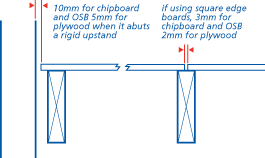
(c) protection of decking
The decking should be installed in dry conditions and be protected from wetting until the roof is complete. The joints in sheet materials which are pre-felted or coated should be sealed immediately after fixing.
The amount of decking installed in any working day should be no greater than can be quickly protected from wetting.
Damaged materials and materials that have been adversely affected by moisture should be discarded.
THERMAL INSULATION AND VAPOUR CONTROL LAYERS
Appendix 7.1-A gives details of suitable materials for insulation and vapour control layers for the different types of roof designs.
WARM DECKS
The design should indicate that the vapour control layer is below the insulation and that it is sealed to the weatherproofing at the perimeter and at all penetrations through the roof, eg pipes.
Insulation boards should be kept dry at all stages to prevent:
- lack of bonding
- entrapment of moisture.
The area of insulation laid at any time should be that which can quickly be covered by the weatherproofing or protected from wetting.
Insulation should be fixed in accordance with manufacturers' recommendations.
INVERTED ROOFS
The insulation material for inverted roofs should be suitable for external use and to withstand any traffic.
COLD DECKS
Ventilation should not be blocked by the thickness of the insulation. A minimum of 50mm clear air space should be maintained.
WEATHERPROOFING
Items to be taken into account include:
(a) preparation of surfaces
The structure and the surface to receive the weatherproofing should be checked and approved by the weatherproofing contractor. All nails should be well punched below the surface, which should be even and dry.
Manufacturers' recommendations should be followed on priming upstands, roof outlets, etc to achieve a satisfactory bond with the weatherproofing.
(b) construction sequence
Weatherproofing systems should be laid to the design and specification following the recommendations of the manufacturer. Some proprietary membranes should be laid only by specialist roofing contractors approved by the manufacturer.
It is preferable that the vapour control layer and insulation (if both are required), the weatherproofing and surface finish are laid in one operation by the same contractor.
(c) weather conditions
Sheet membranes should not be laid or handled when the air temperature is:
- 0°C or below, for lighter types
- less than 5°C, for heavier types.
Manufacturers' recommendations for 'conditioning', unrolling in advance of laying, etc should be followed.
Membranes should not be laid on damp or frosted surfaces or when any rain, sleet or snow is falling.
(d) correct detailing
Appendix 7.1-A gives, for the different roof types, typical details of:
- abutments
- parapets
- edge details
- fixing of guarding
- projections through the waterproofing
- roof lights.
GUARDING TO BALCONIES
Items to be taken into account include:
(a) strength and movement of masonry balcony walls
Masonry balcony walls should be built in accordance with Chapter 6.1 'External masonry walls'. In particular, ensure that:
- walls incorporate strengthening as required by the design
- movement joints are provided in accordance with the design
- copings are firmly bedded.
(b) fixing of balustrading and guard rails
Balustrading and guard rails should be fixed in accordance with the design details. Reference should also be made to Appendix 7.1-C.
Checks should be made that there are no gaps in the guarding that a 100mm sphere can pass through.
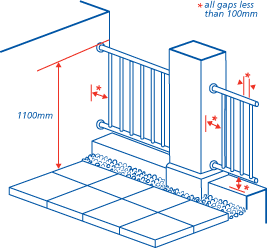
PROTECTION OF MATERIALS FROM WEATHER
Timber-based roof decking and insulation materials should be stored under cover to prevent wetting.
Timber-based roof decks that have been fixed in position should be temporarily covered to prevent wetting, unless the weatherproofing is to be laid immediately.





















